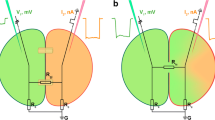Abstract
Gap junctions are groups of membrane-bound channels that allow the passage of small molecules and ions between cells, permitting cell-cell communication. Because of their importance in cell homeostasis, gap junction presence and function were characterized in three commonly studied rainbow trout cell lines, namely RTgill-W1, RTgutGC, and RTG-2. Firstly, gap junction presence was determined by screening for gap junction protein alpha 7 and alpha 1 (GJA7 and GJA1) presence at the transcript level and GJA7 at the protein level. GJA7 was successfully identified at both the transcript and protein levels, and GJA1 was detected at the transcript level in all three cell lines. This is the first report of a GJA7 full-length transcript sequence in rainbow trout cells. Gap junction function, as determined by gap junction intercellular communication (GJIC), was examined using Lucifer yellow dye migration with the scrape and load technique; visualized by fluorescence microscopy. Phorbol 12-myristate 13-acetate (PMA), a gap junction inhibitor, was used to confirm the presence of functional gap junctions. Effects of serum deprivation on GJIC were also monitored; 24-h serum deprivation resulted in greater dye migration compared with 30-min serum deprivation. Both RTG-2 and RTgill-W1 showed significant dye migration that was inhibited by PMA while RTgutGC did not. Human foreskin fibroblast (HFF-1) cells were used as a positive control for gap junction presence and function. Taken together, our study shows that rainbow trout cells express connexin transcripts and proteins, and RTG-2 and, to a lesser extent, RTgill-W1 cells are able to perform GJIC.







Similar content being viewed by others
References
Baldwin LA, Calabrese EJ (1994) Gap junction-mediated intercellular communication in primary cultures of rainbow trout hepatocytes. Ecotoxicol Env Safety 28:201–207
Berthelot C, Brunet F, Chalopin D, Juanchich A, Bernard M, Noël B et al (2014) The rainbow trout genome provides novel insights into evolution after whole-genome duplication in vertebrates. Nat Commun 5:3557
Cruciani V, Mikalsen SO (2006) The vertebrate connexin family. Cell Mol Life Sci 63:1125–1140
Curtis RL, Trier JS, Frizzell RA, Lindem NM, Madara JL (1984) Flounder intestinal absorptive cells have abundant gap junctions and may be coupled. Am J Phys 246:C77–C83
de Montgolfier B, Dufresne J, Letourneau M, Nagler JJ, Fournier A, Audet C, Cyr DG (2007) The expression of multiple connexins throughout spermatogenesis in the rainbow trout testis suggests a role for complex intercellular communication. Biol Reprod 76:208
Falk MM (2000) Biosynthesis and structural composition of gap junction intercellular membrane channels. Eur J Cell Bio 79:564–574
Goodenough DA, Goliger JA, Paul DL (1996) Connexins, connexons, and intercellular communication. Annu Rev Biochem 65:475–502
Goodenough DA, Paul DL (2009) Gap junctions. Cold Spring Harb Perspect Biol 1:a002576
Hutnik CML, Nocrnich CE, Liu H, Laird DW, Shao Q (2008) The protective effect of functional connexin43 channels on a human epithelial cell line exposed to oxidative stress. Invest Ophthalmol Vis Sci 49:800–806
Krysko DV, Mussche S, Leybaert L, D’Herde K (2004) Gap junctional communication and connexin43 expression in relation to apoptotic cell death and survival of granulosa cells. J Histochem Cytochem 52:1199–1207
Kumar S, Stecher G, Tamura K (2016) MEGA7: Molecular Evolutionary Genetics Analysis version 7.0 for bigger datasets. Mol Biol Evol 33:1870–1874
Matic M, Evans WH, Brink PR, Simon B (2002) Epidermal stem cells do not communicate through gap junctions. J Invest Dermatol 118:110–116
Osgood RS, Upham BL, Hill T, Helms KL, Velmurugan K, Babica P, Bauer AK (2013) Polycyclic aromatic hydrocarbon-induced signaling events relevant to inflammation and tumorigenesis in lung cells are dependent on molecular structure. PLoS One 8:e65150
Sandbacka M, Lilius H, Enkvist MOK, Isomaa B (1998) Rainbow trout gill epithelial cells in primary culture communicate through gap junctions as demonstrated by dye-coupling. Fish Physiol Biochem 19:287–292
Schlie-Wolter S, Ngezahayo A, Chichkov BN (2013) The selective role of ECM components on cell adhesion, morphology, proliferation and communication in vitro. Exp Cell Res 319:1553–1561
Sharrow AC, Li Y, Micsenyi A, Griswold RD, Wells A, Monga SSP, Blair HC (2008) Modulation of osteoblast gap-junction connectivity by serum, TNF-alpha and TRAIL. Exp Cell Res 314:297–308
Slater MA, Mosser DD, Bols NC (1983) Established cell lines from different groups of vertebrates undergo metabolic cooperation with one another. In Vitro 19:683–692
Söhl G, Willecke K (2003) An update on connexin genes and their nomenclature in mouse and man. Cell Commun Adh 10:173–180
Sovadinova I, Babica P, Boke H, Kumar E, Wilke A, Park JS, Trosko JE, Upham BL (2015) Phosphatidylcholine specific PLC-induced dysregulation of gap junctions, a robust cellular response to environmental toxicants and prevention by resveratrol in a rat liver cell model. PLoS One 10:e0124454
Tateishi K, He J, Taranova O, Liang G, D’Alessio AC, Zhang Y (2008) Generation of insulin-secreting islet-like clusters from human skin fibroblasts. J Biol Chem 283:31601–31607
Upham BL (2011) Role of integrative signaling through cap junctions in toxicology. Curr Protoc Toxicol 47:2.18:2.18.1–2.18.18
Willecke K, Eiberger J, Degen J, Eckardt D, Romualdi A, Guldenagel M, Deutsch U, Sohl G (2002) Structural and functional diversity of connexin genes in the mouse and human genome. Biol Chem 383:725–737
Wilson MR, Close TW, Trosko JE (2000) Cell population dynamics (apoptosis, mitosis, and cell-cell communication) during disruption of homeostasis. Exp Cell Res 254:257–268
Zhao Y, Yu L, Xu S, Qiu F, Fan Y, Fu G (2011) Down-regulation of connexin43 gap junction by serum deprivation in human endothelial cells was improved by (−)-epigallocatechin gallate via ERK MAP kinase pathway. Biochem Biophys Res Commun 404:217–222
Acknowledgements
The authors wish to thank Dr. Niels Bols for supplying RTG-2, RTgutGC, and RTgill-W1 cells for this study. This work was funded by an NSERC Discovery grant (SDO).
Author information
Authors and Affiliations
Corresponding author
Additional information
Editor: Tetsuji Okamoto
Rights and permissions
About this article
Cite this article
Hooper, J., Poynter, S.J. & DeWitte-Orr, S.J. Identifying connexin expression and determining gap junction intercellular communication in rainbow trout cells. In Vitro Cell.Dev.Biol.-Animal 53, 406–416 (2017). https://doi.org/10.1007/s11626-017-0138-1
Received:
Accepted:
Published:
Issue Date:
DOI: https://doi.org/10.1007/s11626-017-0138-1




